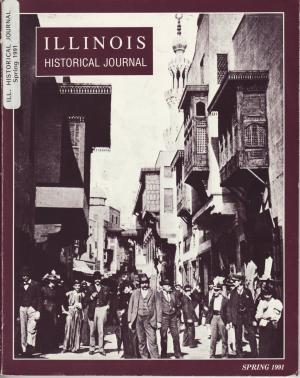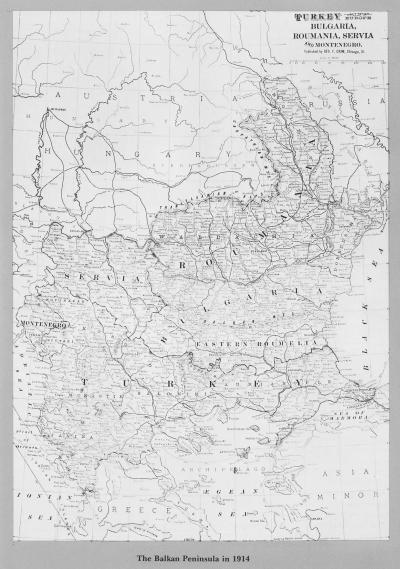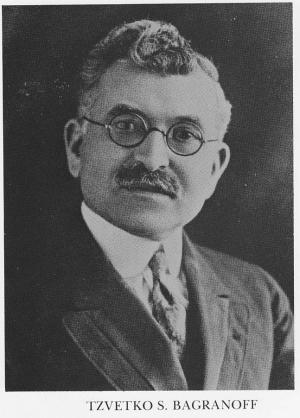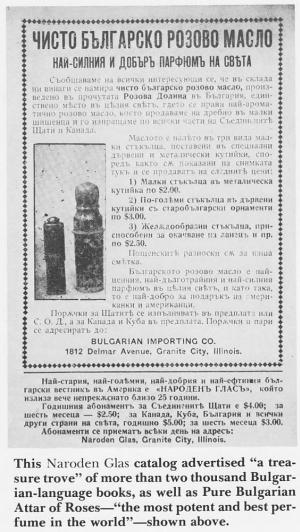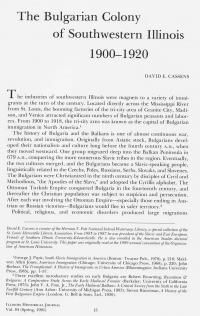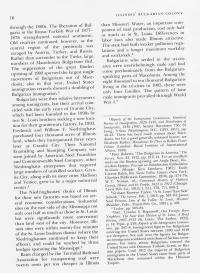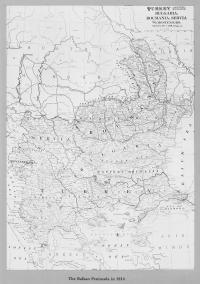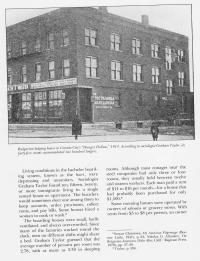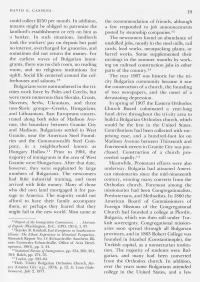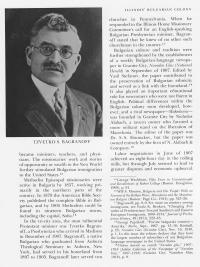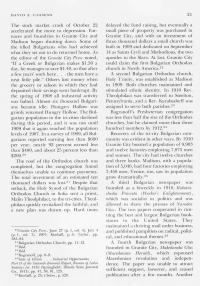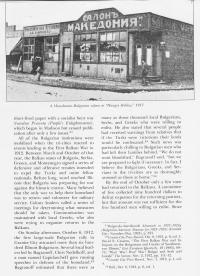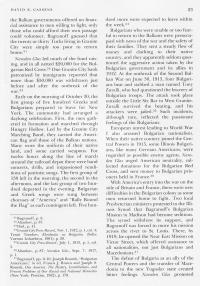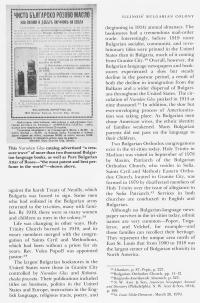Illinois Historical Journal, Vol.
84 (Spring, 1991)
The Bulgarian Colony of Southwestern Illinois,
1900-1920
DAVID E. CASSENS
The Bulgarian Colony of Southwestern Illinois,
1900-1920
DAVID E. CASSENS
David E. Cassens is curator of the Herman T. Pott National Inland Waterways Library, a special collection of the St. Louis Mercantile Library Association. From 1985 to 1987 he was president of the Slavic and East European Friends of Southern Illinois University-Edwardsville. He is also enrolled in the American Studies doctoral program at St. Louis University. This paper was originally read at the 1989 annual convention of the Organization of American Historians.
The industries of southwestern Illinois were magnets to a variety of immigrants at the turn of the century. Located directly across the Mississippi River from St. Louis, the booming factories of the tri-city area of Granite City, Madison, and Venice attracted significant numbers of Bulgarian peasants and laborers. From 1900 to 1918, the tri-city area was known as the capital of Bulgarian immigration in North America.(1)
The history of Bulgaria and the Balkans is one of almost continuous war, revolution, and immigration. Originally from Asiatic stock, Bulgarians developed their nationalism and culture long before the fourth century a.d., when they moved westward. One group migrated deep into the Balkan Peninsula in 679 a.d., conquering the more numerous Slavic tribes in the region. Eventually, the two cultures merged, and the Bulgarians became a Slavic-speaking people, linguistically related to the Czechs, Poles, Russians, Serbs, Slovaks, and Slovenes. The Bulgarians were Christianized in the ninth century by disciples of Cyril and Methodious, "the Apostles of the Slavs," and adopted the Cyrillic alphabet. The Ottoman Turkish Empire conquered Bulgaria in the fourteenth century, and thereafter the Christian population was subject to suspicion and persecution. After each war involving the Ottoman Empire—especially those ending in Austrian or Russian victories—Bulgarians would flee to safer territory.(2)
Political, religious, and economic disorders produced large migrations through the 1800s. The liberation of Bulgaria in the Russo-Turkish War of 1877-1878 strengthened national sentiment. Old rivalries continued, however, as the central region of the peninsula was ravaged by Austria, Turkey, and Russia. Rather than surrender to the Turks, large numbers of Macedonian Bulgarians fled. The suppression of the great Ilinden uprising of 1903 spurred the largest single movement of Bulgarians out of Macedonia; also in that year, United States immigration records showed a doubling of Bulgarian immigration.(3)
Bulgarians were thus relative latecomers among immigrants, but their arrival coincided with the early years of Granite City, which had been founded in the 1890s by two St. Louis brothers seeking a new location for their graniteware factory. In 1893, Frederick and William F. Niedringhaus purchased four thousand acres of Illinois land, which they incorporated three years later as Granite City. Their National Enameling and Stamping Company was soon joined by American Steel Foundries and Commonwealth Steel Company, other Niedringhaus enterprises that required large numbers of unskilled workers. Granite City, along with its sister cities Madison and Venice, grew to be a major industrial center.(4)
The Niedringhauses' choice of Illinois for their new factories was based on several economic considerations. Industrial sites on the east side of the Mississippi not only cost half as much as those in St. Louis but were significantly more convenient than land west of the city. Moreover, Illinois sites were within twenty-five minutes of the St. Louis business district (where the Niedringhauses continued to keep their offices), and could be reached by three bridges spanning the Mississippi.(5)
Rates charged by the Terminal Railroad Association for transporting coal were twenty cents per ton cheaper in Illinois than Missouri. Water, an important component of steel production, cost only half as much as in St. Louis. Differences in labor laws also made Illinois attractive. The state had both weaker pollution regulations and a longer maximum workday and workweek.(6)
Bulgarians who settled in the tri-city area were overwhelmingly male and had come predominately from the Bulgarian-speaking parts of Macedonia. Among the eight thousand to ten thousand Bulgarians living in the tri-cities in 1905, there were only four families. The pattern of lone male immigrants prevailed through World War I.(7)
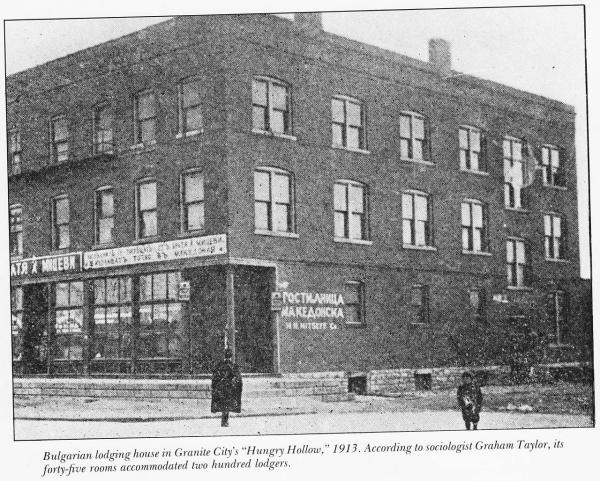 |
| Bulgarian lodging house in
Granite City's "Hungry Hollow," 1913. According to sociologist Graham Taylor, its forty-five rooms accommodated two hundred lodgers. |
The boarding houses were small, badly ventilated, and always overcrowded. Since many of the factories worked round the clock, men on different shifts might share a bed. Graham Taylor guessed that the average number of persons per room was 2.78, with as many as 3.30 in sleeping rooms. Although most cottages near the steel companies had only three or four rooms, they usually held between twelve and sixteen workers. Each man paid a rent of $14 to $16 per month—for a house that had probably been purchased for only $1,500.(9)
Some rooming houses were operated by owners of saloons or grocery stores. With rents from $5 to $8 per person, an owner could collect $250 per month. In addition, tenants might be obliged to patronize the landlord's establishment or rely on him as a banker. In such situations, landlords took the workers' pay on deposit but paid no interest, overcharged for groceries, and sometimes did not return the money. For the earliest waves of Bulgarian immigrants, there was no club room, no reading room, and no religious institutions for uplift. Social life centered around the coffeehouses and saloons.(10)
Bulgarians were outnumbered in the tri-cities work force by Poles and Czechs, but were more numerous than Slovaks, Croats, Slovenes, Serbs, Ukranians, and three non-Slavic groups—Greeks, Hungarians, and Lithuanians. East Europeans concentrated along both sides of Madison Avenue, the boundary between Granite City and Madison. Bulgarians settled in West Granite, near the American Steel Foundries and the Commonwealth Steel Company, in a neighborhood known as Hungary Hollow.(11) Prior to 1904, the majority of immigrants in the area of West Granite were Hungarians. After that date, however, they were supplanted by large numbers of Bulgarians. The newcomers had little industrial training, and most arrived with little money. Many of those who did own land mortgaged it for passage to America. The majority could not afford to have their family accompany them, or perhaps they feared that they might fail in the new world. Most came at the recommendation of friends, although a few responded to job announcements posted by steamship companies.(12)
The newcomers found an abundance of unskilled jobs, mostly in the steel mills, rail yards, lead works, meatpacking plants, or barrel works. Some supplemented their earnings in the summer months by working on railroad construction jobs in other parts of the country.(13)
The year 1907 was historic for the tri-city Bulgarian community because it saw the construction of a church, the founding of two newspapers, and the onset of a devastating depression.
In spring of 1907 the Eastern Orthodox Church Board culminated a year-long fund drive throughout the tri-city area to build a Bulgarian Ordiodox church, which would be the first in the United States. Contributions had been collected with surprising ease, and a hundred-foot lot on Madison Avenue between Thirteenth and Fourteenth streets in Granite City was purchased. Construction of a church proceeded rapidly.(14)
Meanwhile, Protestant efforts were also underway. Bulgaria had attracted American missionaries since the mid-nineteenth century, winning many converts from the Orthodox church. Foremost among the missionaries had been Congregationalists, Presbyterians, and Methodists. In 1860 the American Board of Commissioners of Foreign Missions of the Congregational Church had founded a college at Plovdiv, Bulgaria, which was then still under Turkish sovereignty. Congregational missionaries soon spread through all Bulgarian provinces, and in 1863 Robert College was founded in Istanbul (Constantinople), the Turkish capital, as a nonsectarian institution. The majority of students were Bulgarian, and many had been converted from the Ordiodox church. In addition, over the years some Bulgarians attended college in the United States, and a few became ministers, teachers, and physicians. The missionaries' work and stories of opportunity or wealth in the New World further stimulated Bulgarian immigration to the United States.(15)
Methodist Episcopal missionaries were active in Bulgaria by 1857, working primarily in the northern parts of the country. In 1878 the American Bible Society published the complete Bible in Bulgarian, and by 1905 Methodists could be found in nineteen Bulgarian towns, including the capital, Sofia.(16)
In the tri-city area, the most influential Protestant minister was Tzvetko Bagranoff, a Presbyterian who arrived in Madison in December of 1907. Bagranoff, a native Bulgarian who graduated from Auburn Theological Seminary in Auburn, New York, had served in his homeland from 1897 to 1905. Bagranoff later served two churches in Pennsylvania. When he responded to the Illinois Home Missionary Committee's call for an English-speaking Bulgarian Presbyterian minister, Bagranoff stated that he knew of no other such churchman in the country.(17)
Bulgarian culture and tradition were further strengthened by the establishment of a weekly Bulgarian-language newspaper in Granite City, Naroden Glas (National Herald) in September of 1907. Edited by Vasil Stefanov, the paper contributed to the preservation of Bulgarian ethnicity and served as a link with the homeland.(18) It also played an important educational role for newcomers who were not fluent in English. Political differences within the Bulgarian colony soon developed, however, and a rival newspaper—Makedonia— was founded in Granite City by Nicholas Alabach, a tavern owner who favored a more militant stand on the liberation of Macedonia. The editor of the paper was Dr. S. S. Shumakov, but the paper was owned entirely by the firm of N. Alabach & Company.(19)
Labor negotiations in June of 1907 achieved an eight-hour day in the rolling mills, but through July seemed to lead to greater disputes and economic upheaval.
The stock market crash of October 22 accelerated the move to depression. Furnaces and foundries in Granite City and Madison began shutting down. Some of the idled Bulgarians who had achieved what they set out to do returned home. As the editor of the Granite City Press noted, "If a Greek or Bulgarian makes $1.50 a day, he manages to save $ 1.40, so that after a few years' work here . . . the men have a neat little pile." Others lost money when the grocery or saloon in which they had deposited their savings went bankrupt. By the spring of 1908 all industrial activity was halted. Almost six thousand Bulgarians became idle. Hungary Hollow was grimly renamed Hungry Hollow. The Bulgarian population in the tri-cities declined during this period, and it was not until 1909 that it again reached the population levels of 1907. In a survey of 1909, all Bulgarians reported earning less than $600 per year; nearly 92 percent earned less than $400, and about 25 percent less than $200.(20)
The roof of the Orthodox church was completed, but the congregation found themselves unable to continue payments. The total investment of an estimated ten thousand dollars was lost.(21) Despite that setback, the Holy Synod of the Bulgarian Orthodox Church in Sofia sent a priest, Malin Theolphilact, to the tri-cities. Theolphilact quickly revitalized the faithful, and a new plan was drawn up. Hard times delayed the fund raising, but eventually a small piece of property was purchased in Granite City, and with an investment of three thousand dollars a small church was built in 1909 and dedicated on September 14 as Saints Cyril and Methodious, the two aposdes to the Slavs. At last, Granite City could claim the first Bulgarian Orthodox church in North America.(22)
A second Bulgarian Orthodox church, Holy Trinity, was established at Madison in 1909. Both churches maintained and stimulated ethnic identity. In 1910 Rev. Theolphilact was transferred to Steelton, Pennsylvania, and a Rev. Karabasheff was assigned to serve both parishes.(23)
Bagranoff's Presbyterian congregation was less than half the size of the Orthodox churches, but he claimed more than three hundred members by 1912.(24)
Recovery of the tri-city Bulgarian community was evident in other ways. By 1910 Granite City boasted a population of 9,903 and twelve factories employing 7,875 men and women. The city had twelve churches and three banks. Madison, with a population of 5,046, had four factories employing 3,450 men. Venice, too, saw its population grow dramatically.(25)
A third Bulgarian newspaper was founded as a biweekly in 1910, Rabotnicheska Prosveta (Worker's Enlightenment), which was socialist in politics and was allowed to share the presses of Naroden Glas. The two papers cooperated in running the best and largest Bulgarian bookstores in the United States. They maintained a thriving mail order business, and published pamphlets on radical, political, and educational themes.(26)
A fourth Bulgarian newspaper was founded in Granite City, Makedonska Glas (Macedonian Herald), which espoused Macedonian revolution and independence. The paper was unable to attract sufficient support, however, and ceased publication after a few months. Another short-lived paper with a socialist bent was Narodna Prosveta (People's Enlightenment), which began in Madison but ceased publication after only a few issues.(27)
All of the Bulgarian institutions were mobilized when the tri-cities reacted to events leading to the First Balkan War in 1912. Between March and October of that year, the Balkan states of Bulgaria, Serbia, Greece, and Montenegro signed a series of defensive and offensive treaties intended to expel the Turks and unite fellow nationals. Before long, word reached Illinois that Bulgaria was preparing for war against the historic enemy. Many believed that the only way to help their homeland was to return and volunteer for military service. Colony leaders called a series of meetings for determining what measures should be taken. Communication was maintained with local Greeks, who also were trying to organize returns to the Balkans.
On Sunday afternoon, October 6, 1912, the first large-scale Bulgarian rally in Granite City attracted more than six hundred Illinois Bulgarians. Several local leaders led by Bagranoff, Chris Nedelkoff, and a man named Capidancheff gave rousing speeches in defense of the homeland.(28) Bagranoff estimated that there were as
many as three thousand local Bulgarians, Serbs, and Greeks who were willing to enlist. He also stated that several people had received warnings from relatives that if the Turks were victorious their lands would be confiscated.(29) Such news was particularly chilling to Bulgarian men who had left their families behind. "We do not want bloodshed," Bagranoff said, "but we are prepared to fight if necessary. In fact, I believe the Bulgarians, Greeks, and Servians in the tri-cities are as thoroughly aroused as those at home."(30)
By the end of October only a few men had returned to the Balkans. A committee of five collected nine hundred dollars to defray expenses for the returning patriots, but that amount was not sufficient for the five hundred men willing to enlist. Since the Balkan governments offered no financial assistance to men willing to fight, only those who could afford their own passage could volunteer. Bagranoff guessed that the twenty or thirty Turks living in Granite City were simply too poor to return home.(31)
Naroden Glas led much of the fund raising, and in all netted $20,000 for the Bulgarian Red Cross.(32) One Granite City bank patronized by immigrants reported that more than $50,000 was withdrawn just before and after the outbreak of the war.(33)
Early on the morning of October 30, the first group of five hundred Greeks and Bulgarians prepared to leave for New York. The community had arranged a daylong celebration. First, the men gathered in formation and marched through Hungry Hollow. Led by the Granite City Marching Band, they carried the American flag and those of the Balkan nations. Many wore the uniform of their native land, and some carried weapons. For twelve hours along the line of march around the railroad depot there were band concerts, drills, and impassioned renditions of patriotic songs. The first group of 150 left in the morning, the second in the afternoon, and the last group of two hundred departed in the evening. Bulgarian and Greek songs were sung between choruses of "America" and "Rally Round the Flag" as each contingent left. Five hundred more were expected to leave within the week.(34)
Bulgarians who were unable or too fearful to return to the Balkans were preoccupied with news of the war and the safety of their families. They sent a steady flow of money and clothing to their native country, and they apparently seldom questioned the aggressive action taken by the Bulgarian government and its allies in 1912. At the outbreak of the Second Balkan War on June 30, 1913, four Bulgarians beat and stabbed a man named Tony Zuralli, who had questioned the bravery of Bulgarian troops. The attack took place outside the Little Six Bar in West Granite. Zuralli survived the beating, and his attackers were jailed.(35) Such incidents, although rare, reflected the passionate feelings of the Bulgarians.
European unrest leading to World War I also aroused Bulgarian nationalism. When their native country joined the Central Powers in 1915, some Illinois Bulgarians, like many German Americans, were regarded as possible enemy agents. Naroden Glas urged American neutrality, collected donations for the Bulgarian Red Cross, and sent money to Bulgarian prisoners held in France.(36)
With America's entry into the war on the side of Britain and France, there were new difficulties in the Bulgarian colony as some men returned home to fight. Two local Presbyterian ministers protested to the Illinois Synod that Bagranoffs Bulgarian Mission in Madison had become seditious. The synod withdrew its support, and Bagranoff was forced to move his mission across the river to St. Louis. There, by 1919, he opened the Near East Mission on Victor Street, which offered assistance to all nationalities, not just Bulgarians and Macedonians.(37)
The defeat of Bulgaria as an ally of the Central Powers and the transfer of Macedonia to the new Yugoslav state created bitter feelings. Naroden Glas protested against the harsh Treaty of Neuilly, which Bulgaria was forced to sign. Some men who had enlisted in the Bulgarian army returned to the tri-cities, many with families. By 1919, there were as many women and children as men in the colony.(38)
Life was changing in other ways. Holy Trinity Church burned in 1919, and its weary members merged with the congregation of Saints Cyril and Methodious, which had been without a priest for six years. Rev. Volco Popoff was appointed pastor.(39)
The largest Bulgarian bookstores in the United States were those in Granite City controlled by Naroden Glas and Rabotnicheska prosveta. Their publications included titles on business, politics in the United States and Europe, instruction in the English language, religious tracts, poetry, and (beginning in 1914) annual almanacs. The bookstores had a tremendous mail-order trade. Interestingly, before 1919 more Bulgarian socialist, communist, and revolutionary titles were printed in the United States than in Bulgaria, much of it coming from Granite City.(40) Overall, however, the Bulgarian-language newspapers and bookstores experienced a slow but steady decline in the postwar period, a result of both the decline in immigration from the Balkans and a wider dispersal of Bulgarians throughout the United States. The circulation of Naroden Glas peaked in 1914 at nine thousand.(41) In addition, the slow but ever-enveloping process of Americanization was taking place. As Bulgarian men chose American wives, the ethnic identity of families weakened. Many Bulgarian parents did not pass on the language to their children.
Two Bulgarian Orthodox congregations exist in the tri-cities today. Holy Trinity in Madison was visited in September of 1978 by Maxim, Patriarch of the Bulgarian Orthodox Church, who resides in Sofia. Saints Cyril and Methody Eastern Orthodox Church, located in Granite City, was formed in 1979 by disaffected members of Holy Trinity over the issue of allegiance to the Sofia Patriarch.(42) Services in both churches are conducted in English and Bulgarian.
Although no Bulgarian-language newspaper survives in the tri-cities today, ethnic names are very common—Popov, Tsigalerov, and Velchef, for example—and those families can recollect their heritage. They represent the unique area north of East St. Louis that from 1900 to 1918 was the largest center of Bulgarian ethnicity in North America.
